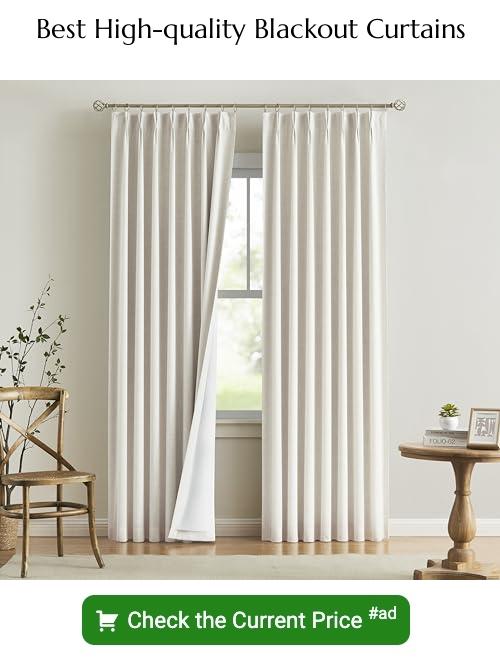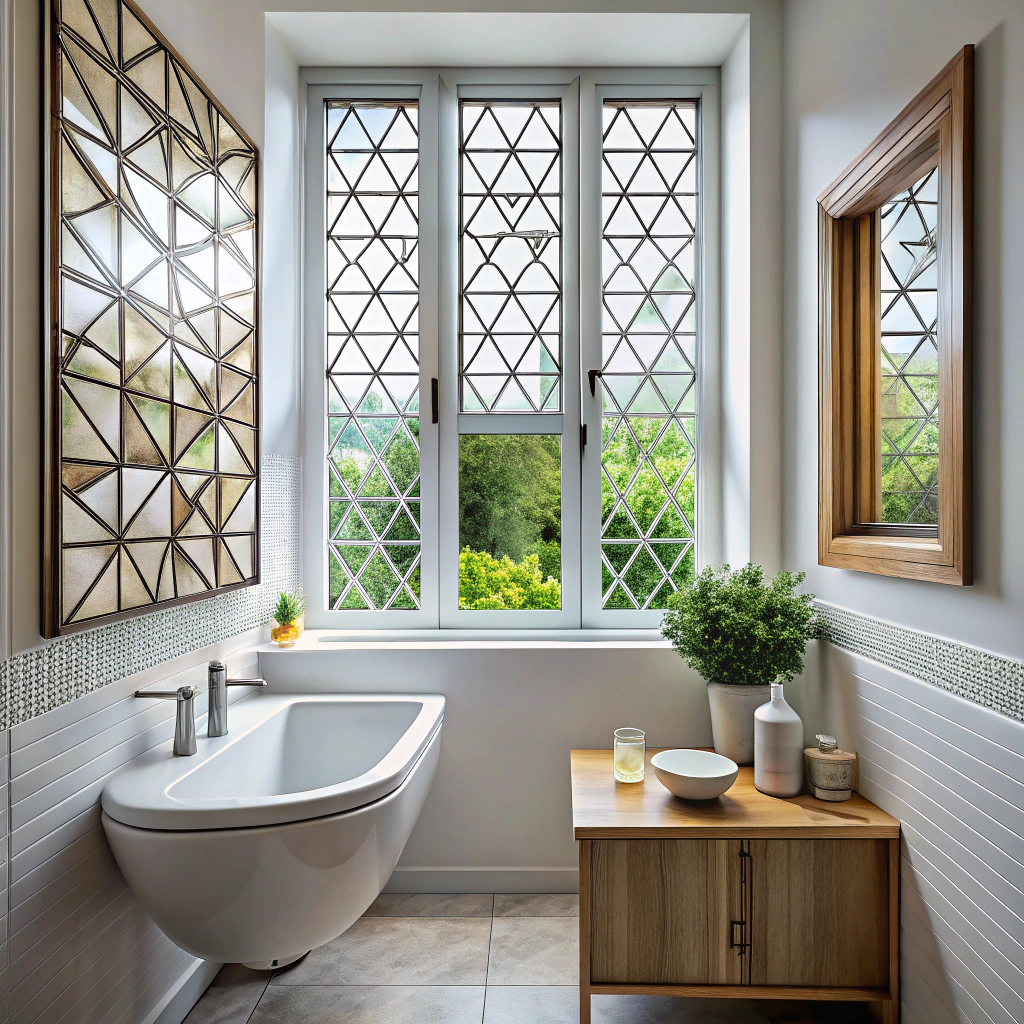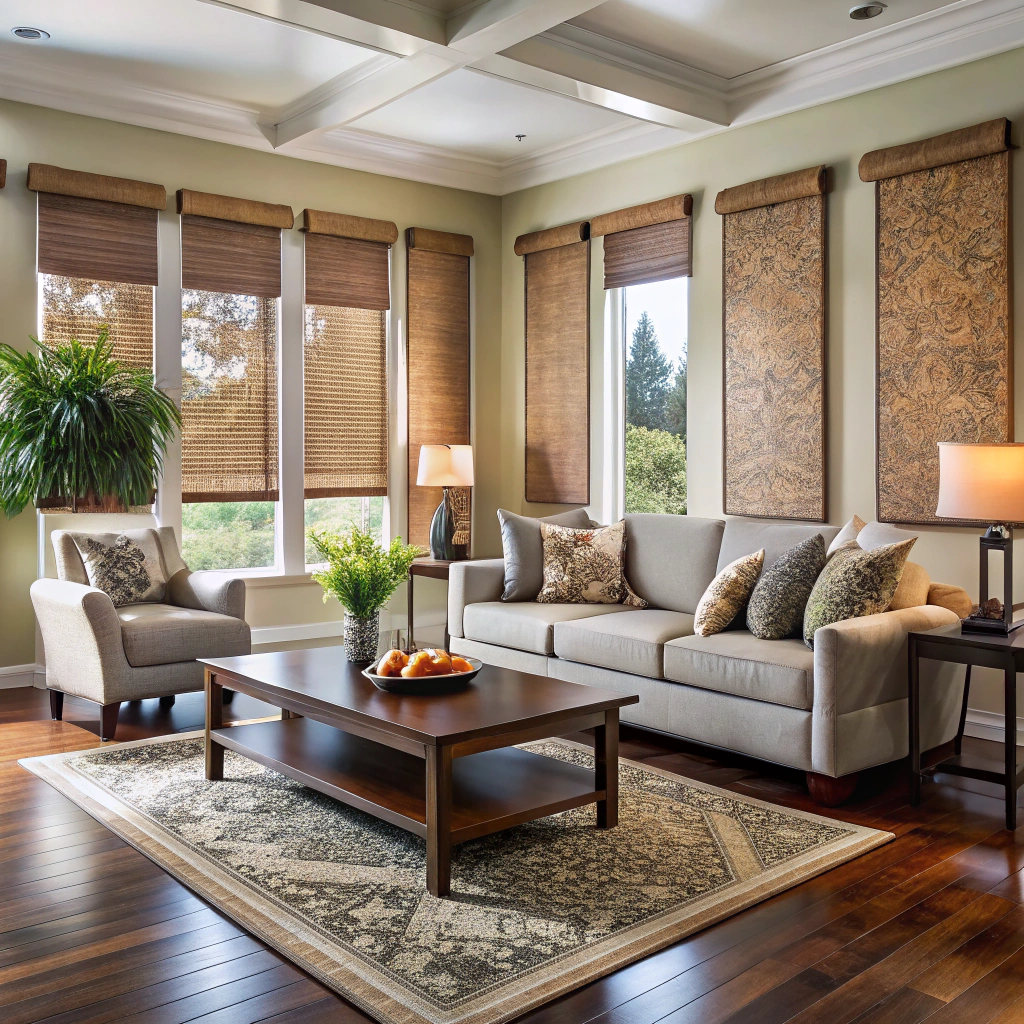Explore the elegance of London shades because their distinctive design can uplift any room’s aesthetics.
Key takeaways:
- London shades combine drapery and blinds for a chic look.
- They feature horizontal pleats and create a ballooning effect.
- London shades are versatile and work with various interior styles.
- They offer light control and can block out sunlight.
- Fabric choices range from casual to opulent, depending on the desired look.
Definition of a London Shade
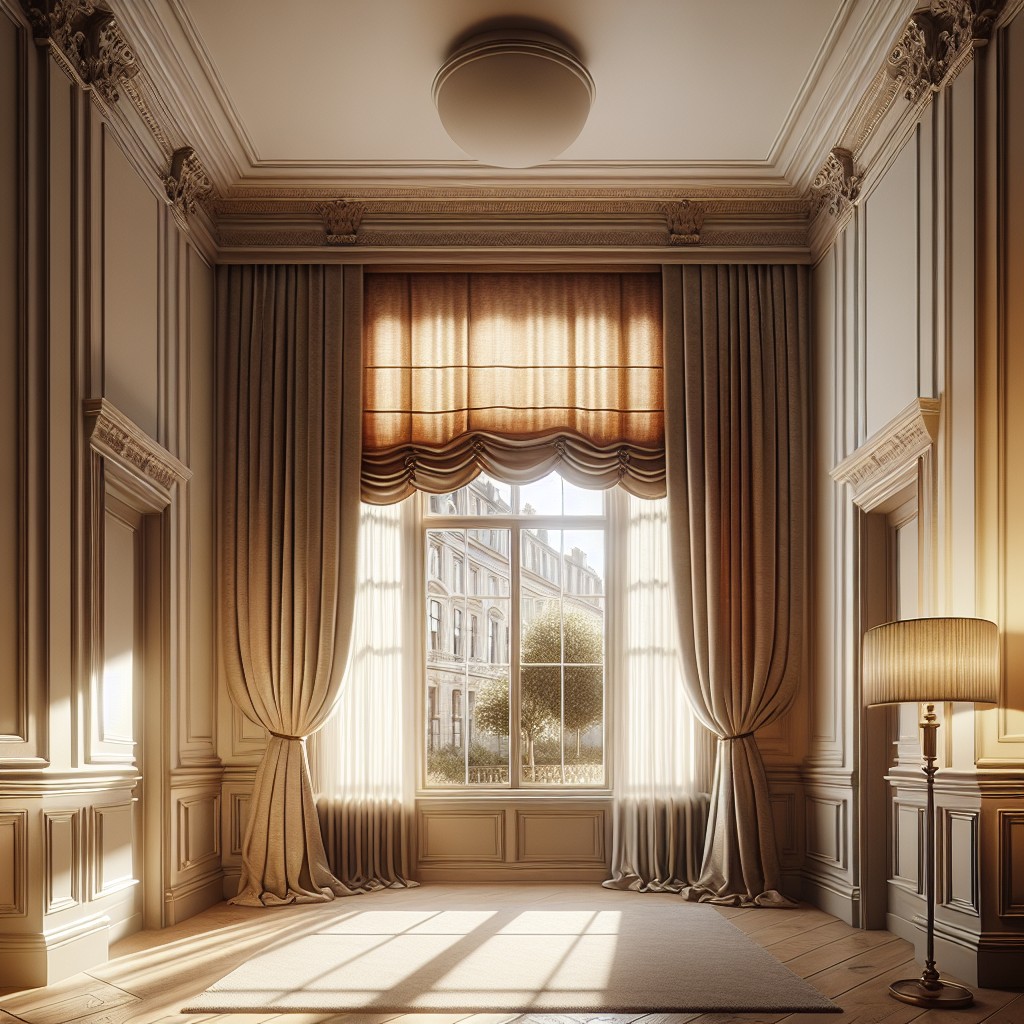
A London Shade is a window covering that combines the softness of drapery with the functionality of a blind. This shade is distinct for its chic, tailored look and features horizontal tucks or pleats about one-third of the way down, which create a gentle ballooning effect when the shade is raised.
Unlike flat Roman shades that remain smooth when drawn up, the London Shade’s design allows for a more ornamental and voluminous silhouette, adding a touch of elegance to any room.
These shades are versatile, compatible with both casual and formal interior styles, and can be made from a broad range of fabrics to match various decor themes.
Design Characteristics
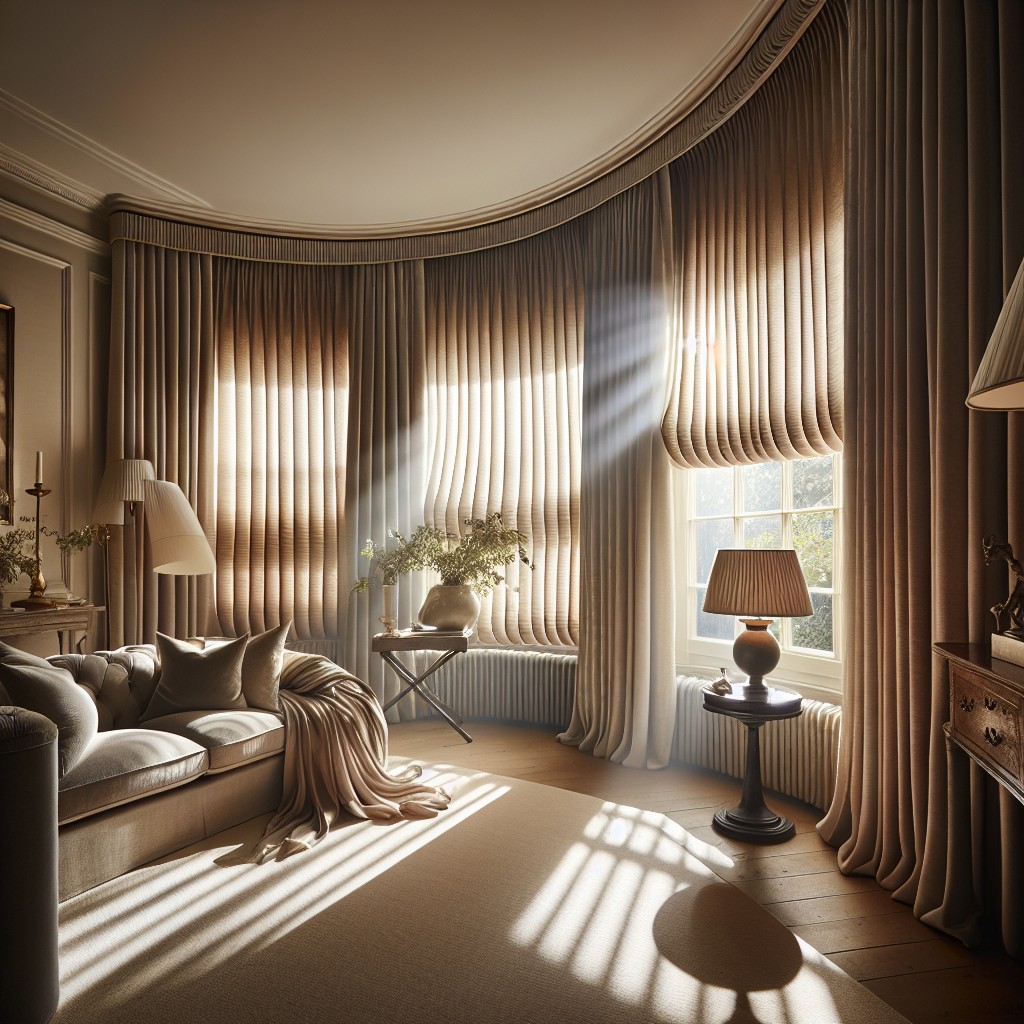
London shades boast a distinctive aesthetic that combines the elegance of Roman shades with the whimsy of curtains. The design features gentle swags that arise from two distinct sections of the fabric when raised, creating a soft, feminine silhouette.
These shades often include strategically placed cords that allow the fabric to drape in an artistic fashion while maintaining a casual, unfussy look. When lowered, the shade appears as a flat panel, showcasing the fabric’s pattern and texture, while the edges typically reveal an attractive, slightly ruffled frame.
Ideal for rooms that benefit from a touch of formal yet inviting decor, they serve as a captivating focal point in both traditional and contemporary interiors.
Functionality of London Shades
London shades blend the elegance of drapery with the functionality of a traditional blind. They operate with a cord system that allows the shade to be raised or lowered to the desired height. When raised, the fabric gathers into gentle folds, creating a soft, romantic look. Unlike flat Roman shades that appear smooth when drawn up, London shades maintain their delicate folds, even when fully raised, adding depth and texture to a room.
These shades offer versatile light control; when fully extended, they can block out sunlight or provide privacy. Partially raising them allows natural light to filter through while still offering some privacy. Additionally, the functionality of the cord system is usually straightforward, making them an easy-to-operate choice for homeowners. However, for increased safety, especially in homes with small children or pets, a cordless option or a motorized system can be installed, allowing for a smoother and safer operation.
Fabric Choices for London Shades
Selecting the right fabric is crucial to the aesthetic appeal and functionality of London shades. Lighter materials such as cotton or linen offer a casual look while allowing natural light to filter through. For a more opulent feel or extra privacy, heavier fabrics like velvet or brocade are ideal.
If insulation is a concern, consider a thicker textile or a lined shade to help control indoor temperatures. To achieve the distinctive folds and tails of a London shade, always opt for a fabric with a soft drape. Fabrics with some body yet pliability, such as a soft chenille, work well.
Also, ponder the care requirements; some materials may necessitate dry-cleaning, whereas others are machine washable, influencing ease of maintenance. When integrating the shade into your existing décor, ensure the fabric’s pattern and texture complement the room’s style and color palette.
Installation Process
Installing London shades involves a few key steps to ensure a secure and attractive appearance. First, measure the width of the window to determine the size of the shade needed. Brackets must be mounted either inside the window frame or on the wall above it, depending on the desired look. The tools typically required include a drill, screwdriver, level, and pencil for marking.
When mounting, always check for levelness to ensure the shade will hang straight. London shades use a series of rings on the back that connect to cords for raising and lowering the shade. After securing the brackets, attach the shade and thread the cords through the pulley system. An important tip is to keep the cords evenly tensioned, so the folds of the shade drape gracefully. Safety devices also must be installed to keep cords out of the reach of children and pets.
For a seamless finish, fasten the cleat or cord lock to the side of the window to manage the drawstrings. Testing the mechanism by pulling the cords to raise and lower the shade is a critical final step to ensure proper functionality.
Maintenance and Cleaning of London Shades
London shades, for all their elegance, require regular maintenance to ensure their longevity and visual appeal. Dust and dirt can collect on the folds and diminish the fabric’s luster. To care for these shades properly:
1. Dust Regularly: Use a soft cloth or a feather duster to gently remove surface dust. This should be done weekly to prevent buildup.
2. Vacuum with Care: For a deeper clean, use the upholstery attachment on your vacuum cleaner. Select a low suction setting to avoid damaging the fabric and go over the shades delicately.
3. Spot Clean: Address spills or stains immediately by blotting with a clean, damp cloth. Avoid rubbing to prevent the stain from spreading.
4. Avoid Water for Certain Fabrics: If your shades are made of silk or another fabric that is sensitive to water, refrain from using water for cleaning. Consult care labels or professional cleaners.
5. Professional Dry Cleaning: For an extensive refresh or in the case of delicate materials, taking your shades to a professional dry cleaner can be a wise choice.
Remember not to dismantle the shades for cleaning unless the manufacturer’s instructions indicate that it’s safe to do so. Regular and prudent maintenance will keep your London shades looking as refined as the day they were installed.
Tie-in With Other Decor Elements
Incorporating London shades into your existing home decor enhances both their appeal and functionality. When selecting fabrics, consider the color scheme, patterns, and textures already present in the room.
For a cohesive look, match the shade’s fabric to an accent color within the space, such as throw pillows or a statement rug. Opt for complementary patterns that don’t clash but rather attractively mix with your upholstery or wallpaper.
The opulent nature of London shades pairs well with classic furniture and rich materials like velvet or silk for an upscale aesthetic. However, a minimalist setting can benefit from simple, light filtering fabrics that add a touch of sophistication without overwhelming the space.
Assessing the room’s overall style – be it traditional, contemporary, or eclectic – can inform your choice of London shades, ensuring they blend seamlessly with your home’s unique character.
Custom London Shade Options
When personalizing London shades to fit your space and style, consider the following options:
- Dimensions: Tailor measurements to ensure a perfect fit for your window dimensions, accounting for both width and length.
- Fabric Type: Choose materials based on the room’s aesthetic and functional needs; opt for light-filtering fabrics for a soft glow or heavier materials for privacy.
- Pattern and Color: Select from a wide range of colors and patterns to match your decor; bold patterns make a statement, while neutral shades blend seamlessly.
- Control Mechanisms: Decide between a standard cord system, a continuous loop chain, or a motorized option for ease of use.
- Lining Options: Add standard lining for light control and privacy, or use thermal or blackout linings for energy efficiency and room darkening.
- Trim and Embellishments: Incorporate decorative trim, fringes, or embroidery to add a personal touch and enhance the shade’s elegance.
By customizing these aspects, you create a unique London shade that not only complements your decor but also meets your functional requirements.
Rod Pocket Valances
Rod pocket valances bring a classic touch to windows, easily sliding onto a rod for a gathered or ruffled appearance. Here are key insights:
- Simple Installation: No need for clips or rings—slide them directly onto the rod.
- Versatility: Suitable for any room, they blend well with various styles from traditional to casual.
- Design Options: Available in different lengths and widths, the fullness can be adjusted to achieve the desired look.
- Fabric Considerations: Light to medium-weight fabrics work best to maintain the valance’s shape and drape.
- Layering Potential: Can be paired with blinds, shades, or curtains for added texture and privacy.
Choosing a rod pocket valance adds an effortless elegance to your space, embodying both utility and style.
Tab Top Valances
Tab top valances bring an effortless charm to any room, characterized by fabric loops that easily slide onto a curtain rod, creating a fluid drape. This style is especially compatible with casual or rustic interiors.
Here are some pertinent points to consider:
- These valances excel in unobstructed hanging, allowing for the showcasing of decorative rods or enhancing minimalistic themes.
- The fabric loops can vary in size, influencing the pleat’s size and the overall aesthetic. Wider loops create a bolder statement, whereas smaller loops offer a more refined look.
- When choosing fabrics, consider light to medium weights to ensure a smooth fall of the valance. Heavier fabrics may weigh down the loops and hinder the intended appearance.
- For extra visual interest, contrasting fabrics or colors can be used for the tabs themselves. This custom touch adds depth and personal flair to your window treatment.
- Because tab top valances are not meant to be drawn, they’re often employed in conjunction with blinds or shades for privacy and light control.
Tips for a successful installation include ensuring even spacing of the tabs and selecting a rod that complements the valance’s design elements. Adjust the rod width for the desired “bunching” effect of the fabric between the tabs.
Board-Mounted Valances
Board-mounted valances offer a structured look, as they are attached to a board that is mounted directly onto the wall or window frame. This style provides a neat appearance since the valance is pulled taut and held in place, showcasing clean lines.
Key points to consider for board-mounted valances include:
- They are ideal for fabrics that benefit from a more rigid presentation, such as heavier materials or textures that maintain shape.
- Installation typically requires brackets and screws, making it more permanent and sturdy compared to other types.
- The wood board can be wrapped in fabric for a cohesive look or painted to match the room’s decor.
- This option works well for hiding hardware used for under treatments, such as blinds or shades.
- Board-mounted valances are customizable in width and length, making them suitable for windows of all sizes.
- They are often used in formal settings or areas where a more architectural element is desired.
Balloon and London Valances
Balloon valances introduce a traditional, voluminous look, puffing out to create a sense of fullness and depth. They often feature gathered fabric and can be a single layer or contain multiple layers for a more intricate appearance.
Contrastingly, London valances present a softer, more tailored look with distinct inverted pleats that produce gentle folds, creating a sense of relaxed elegance.
Both styles are versatile in that they can serve as stand-alone window treatments or accompany other window coverings, such as blinds or draperies, to add a layer of sophistication.
When integrating balloon or London valances into a room, consider the scale and the view—larger windows welcome the drama of a balloon valance, while smaller or moderately sized windows benefit from the understated charm of a London valance.
Flat and M-Shaped Valances
Flat valances are streamlined, offering a clean and modern look to windows. They hang straight with no ruffles or folds, creating an uncluttered aesthetic ideal for contemporary spaces.
In contrast, M-shaped valances, also known as swag valances, feature a distinctive dip in the middle that resembles the letter ‘M’. This dip often drapes elegantly, adding a touch of sophistication and visual interest to the room.
Both styles can be mounted on a decorative rod or a board, and while flat valances complement minimalist decor, M-shaped valances suit traditional or formal settings more aptly.
These valances can be used alone or layered over blinds or shades for additional texture and depth.
Faux Roman Shade Valances
Faux Roman shade valances offer an aesthetic mirroring traditional Roman shades, but without the functionality—they do not raise or lower. These fixed window treatments provide a cost-effective way to achieve a sophisticated look while being purely decorative. They are excellent for areas where privacy is not a concern but where the elegance of fabric window treatments is desired.
Crafted typically from a flat piece of fabric, these valances attach directly to the window frame or on a curtain rod above the window. They appear to have the soft folds of a Roman shade, often with the soft curves at the bottom edge where a true Roman would fold when raised.
The illusion of a full shade is created by either strategic stitching or the arrangement of the fabric. Versatile in design, they can be used alone or paired with functional window treatments, such as blinds or sheers, to add depth and texture to a room. They are an ideal option for introducing color, pattern, or a thematic element without committing to a fully-operational shade.
Popular Faux Shades
Faux shades offer a decorative alternative to traditional window treatments, creating the illusion of a Roman or other structured shade without the full range of motion. These stationary window treatments are primarily aesthetic, serving less to control light and more to add a touch of sophistication to a room.
Notably, faux Roman shades are a prevalent style, presenting the appearance of neatly stacked folds when in fact, they remain fixed in a partially raised position. Faux shades are easy to make, requiring less fabric than operable shades and often come with a simplified installation process.
They work well in spaces where privacy isn’t a primary concern, allowing for unobstructed windows with a polished look. Overall, faux shades are a cost-effective way to achieve elegance without the functionality of traditional shades.
FAQ
What is a London shade?
A London shade is a modern take on the classic Roman style, characterized by its unique construction that involves fabricating it with an updated pattern and can be customized with inset, corded pleats, functional in nature but can be constructed as a stationary valance.
What are London blinds?
London blinds are a distinctive style of window dressing that represents a fusion of Roman and Austrian blinds, characterized by a swagged pleat along the horizontal edge when open and crafted from a single piece of fabric.
How do you install a London shade?
To install a London shade, you need to measure the window, cut and sew the fabric accordingly, attach the roman shade rings, thread the cords, and install it onto the window with brackets.
What materials are commonly used in London shades?
London shades are commonly made from materials like linen, cotton, silk and synthetic mixture fabric.
What are the benefits of using London shades over other window coverings?
London shades offer an elegant aesthetic appeal, functionality with light control, and energy-efficiency due to their insulation properties.
Recap
